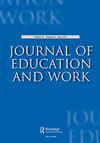‘Being there’: rhythmic diversity and working students
IF 1.7
Q2 EDUCATION & EDUCATIONAL RESEARCH
引用次数: 4
Abstract
ABSTRACT Although universities promote undergraduate degrees as journeys of exploration and reflection, they are also viewed by students as investments in professional careers. This paper draws on a study of 57 second-year students at a research-intensive university in Canada to explore the subjective dimensions of time and school-work rhythms in students’ everyday lives. Data suggest that most students expect to work hard, now and in the future, although their backgrounds influence perceptions of the kind of hard work required, and the magnitude and certainty of returns. Students are future-oriented and participation in term-time work is seen as a way of training for future work lives. This training involves adapting bodies to the temporal logics and rhythms of university studies and workplaces. The interplay of rhythms is experienced by some students as harmonious or ‘eurhythmic’, and by others as discordant or ‘arrhythmic’. The extent of discord is related to differences in students’ work and studies, differences in their time horizons and value calculations, and differences in family background and resources. This paper contends that understanding students’ sense-making in regard to chrono-logics and work-school rhythms is important for building a vision for higher education that better supports human flourishing.“在那里”:节奏多样性与在职学生
虽然大学将本科学位视为探索和反思的旅程,但学生也将其视为对职业生涯的投资。本文以加拿大一所研究型大学的57名二年级学生为研究对象,探讨学生日常生活中时间和课业节奏的主观维度。数据显示,大多数学生希望努力学习,无论是现在还是将来,尽管他们的背景影响了他们对所需要的努力程度、回报的大小和确定性的看法。学生以未来为导向,参加学期工作被视为为未来工作生活训练的一种方式。这种训练包括使身体适应大学学习和工作场所的时间逻辑和节奏。节奏的相互作用对一些学生来说是和谐的或“有节奏的”,而对另一些学生来说是不和谐的或“无节奏的”。不和谐的程度与学生在工作和学习上的差异、他们的时间视野和价值计算的差异以及家庭背景和资源的差异有关。本文认为,了解学生在时间逻辑和工作-学校节奏方面的意义构建对于构建更好地支持人类繁荣的高等教育愿景非常重要。
本文章由计算机程序翻译,如有差异,请以英文原文为准。
求助全文
约1分钟内获得全文
求助全文
来源期刊

Journal of Education and Work
EDUCATION & EDUCATIONAL RESEARCH-
CiteScore
2.70
自引率
14.30%
发文量
40
期刊介绍:
The Journal of Education and Work is an international forum for academic research and policy analysis which focuses on the interplay of the education and economic systems. The journal examines how knowledge, skills, values and attitudes both about and for work and employment are developed within the education system. The journal also explores the various forms of industrial training and accreditation in the economic system, including changes in the economic and industrial infrastructure which influence the type of employees required. Work in the informal economy is also included.
 求助内容:
求助内容: 应助结果提醒方式:
应助结果提醒方式:


